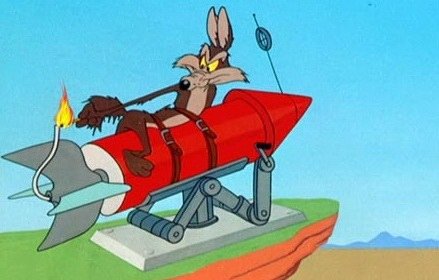
Source
Welcome to the 'Fantasy Zone'! This fast-paced blast from the past will get your blood pumping and your mouse hand flitting in all directions. This is one game where you won't want to blink.
Welcome. This is 'Nostalgic Game Design Focus' a new series where I get to think back and comment upon games that I had played when I was much younger - mostly from a game-design perspective.
Title: Space Harrier
Publishers (EU/WW): Elite/ Sega
Developers: Elite/ Sega/ Dempa/ Rutubo Games
Released: 1985
'Space Harrier' was one of the first games that I got to play as included with the Atari ST(fm) Discovery Pack that me and my brother were gifted with one fine Christmas. It blew my young impressionable mind away.
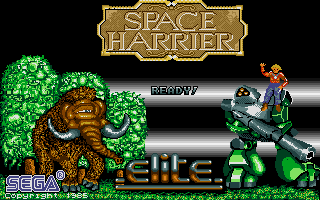
Source
This game could best be described as an 'on-rails' rear-perspective 3rd person shooter.
'Space Harrier' for the most part did a really good job of immersing me.
It may have had the most flimsy of back-stories (that "Fantasy Land" is in trouble) and asks a player to kind of accept that the main protagonist of the game could find no better way to do so than to hold on for dear life to a high-tech blaster that also doubles as the rocket propulsion sending you hurtling through levels... Wile E Coyote had a safer setup!
Riding a dragon instead on the bonus stages was sweet though. _
Once one lets go of such mundane details of realism within the context of an arcade-style video game - the fun can truly begin!
In terms of player abilities - the following sums it up:
You can shoot fast-rotating projectile blasts forward toward the horizon.
You can fly around in the air.
You can run just as fast on the ground.
That is everything - and they did an excellent job of showing how keeping things simple (and implementing it well) can make for a more solid game. No need to add the worry about what weapon works best upon what enemy while hurtling at break-neck speeds.
It was actually a nice touch to have a running animation when on the ground level. It would have been so simple for the developers to just decide that his feet never touches the ground. It was also nice that the flight animation would shift depending on what part of the screen the player is on laterally.
One also gained a sense of the play area expanding a little to either side of the play area. This may have had something to do with the unfortunate choice to feature a completely useless sidebar that served no purpose other than to break the immersion in play as one is constantly reminded that one is playing 'Space Harrier'.
I am guessing that Elite wanted to make sure that they weren't overshadowed by Sega - but this wasn't the best way to go about it (title screen & credits).
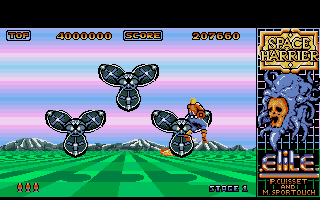
Source
Hurtling Down the Skyway!
In case I hadn't made it clear - this game is very fast-paced! There are two speeds on this game.
'Stopped mode' - which means that one has either lost a life or is dead.
And 'OhMyGawdI'mGonnaDie Mode'. Seriously. The protagonist isn't even seen wearing a bicycle helmet to protect his good looks when he takes a blaster, a spaceship or a column to the face!
And it sounds pretty painful when he does too, letting out a painful-sounding "ARGH!" as his sprite falls to the ground, followed shortly thereafter by the more robotic "Get Ready!" as he gets to his feet. And then he's off again at break-neck speed.
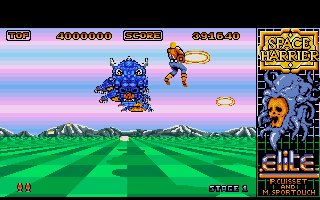
Source
I absolutely adore the checkered ground of the game. It truly conveys the speed and the vibrant atmosphere of the level. The music on the Atari ST was also really nice and though certain voice clips were omitted from the ST version, cannot say that I really missed them - the music was that good.
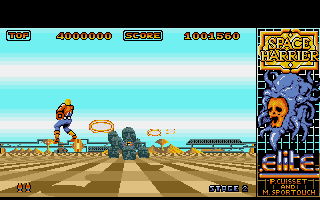
Source
Threats In-Game:
Many of the levels in this game are structurally the same. One hurtles through (runs) "the gauntlet" through waves of obstacles and attack waves of enemies. At the end there is a final boss that needs to be defeated so as to proceed to the next level.
Blasters: Some enemies shoot back. When this happens, rotating blaster bolts appear on screen that a player usually has a very short amount of time to dodge.
Bosses will sometimes opt for broader 'fiery' attacks, often in short successive bursts. These otherwise behave similarly.
Collisions Smack! Its bad enough that things are flying onto and off of screen and past you - but if you aren't careful (and to be clear - its difficult to be very careful in a game like this one) then you can and will find yourself going splat against one of the many hostile or indifferent features on the map.

Source
'Space Harrier' was cleverly designed such that only sprites that are at a certain 'depth' upon the screen afflict the character. This applies for blasters and just about all other things alike.
Normally back then collision-detection was just a matter of seeing if two or more things occupy the same 2D space. Did Mario and the gumba 'touch' each other? Then Mario either gets smaller or loses a life. In 'Space Harrier' a further check is made to check on what 'depth' the sprite is at.
If the sprite is at the same depth as the character then the sprite becomes deadly for that instance. Otherwise the sprites can overlap merrily. This simple check is what makes 'Space Harrier' work out so well. It is what allows a players to traverse a rush of indestructible columns without (too many) death(s).
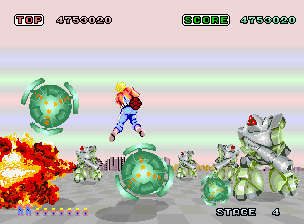
Source
Things that the player can 'bump' into:
Static obstacles Whether its a bush near the ground, a floating meteor in the sky or an exotic column, some things aren't meant to move. Well - they seem to move 'very' quickly - but that's just because you're speeding past them at break-neck speeds.
Some of these obstacles can be satisfyingly destroyed with one's blaster (although my increased ecological sensitivities now feel more conflicted about making trees and bushes explode for 'points').
Others cannot. Here too, the game's design shines through. Rather than simply ignoring the damage, the non-damaging hit produces a different sound and hurls the blaster shot ineffectively back to one side or another. The game 'warns' the player that they are about to go 'splat' - and once new players suffer a few painful 'learning experiences' - this allows for new unfamiliar things to provide life-saving clues as to their non-destructible nature.

Source
Alien Spaceships I'm not sure if its fair to compare these to the smaller spaceships from 'Independence Day' - seeing as that movie came more than a decade 'later' - but its a fairly good comparison.
These ships come in waves of single-file spaceships - often from the front but occasionally from the rear. They are quick and susceptible to blasters - but also like firing blasters themselves.
Armored alien spaceships These ships come from the distance and get into a triangular position. They are armored - but they become vulnerable as they open their shield to fire short-notice blaster shots in unison. After 3 bouts of fire, they move to the background and may result in a collision when doing so.
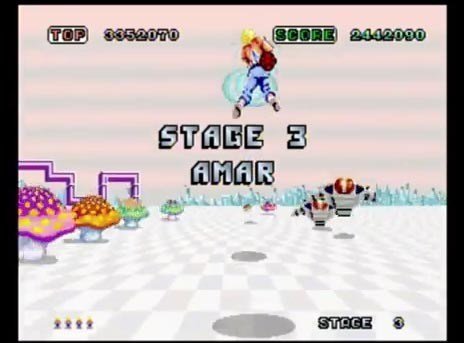
Source
Stoned Heads, Space Robots, Woolly Mammoths, Polyhedral Grids, Leaping Jellies, etc.: There is no shortage of variety in this game. A lot of these enemies can take more than a single shot. Some acts as stationaries. Others move left or right. Others leap to the left or right. Others move in faster. A few even use blasters.
Dragons, & Abstractions: Boss monsters. They each have their own movement and attack patterns. Being able to soak a lot more hits than other stuff on a given level, the boss regales you with an assault of attacks - often fiery or blaster-y in nature - and sometimes collision-based also.
Often, as a boss takes damage, its color will begin to shift. No health-bars here. The whole skin of the creature changes (particularly dragons - though again - it was cool to ride one in the bonus stages).
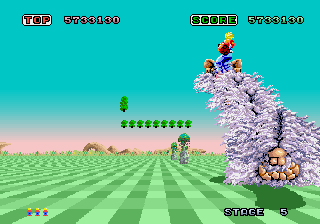
Source
A lot of challenge and, if you didn't need your hand upon the mouse at all times, it'd be nail-biting fun also. The nice thing about games back then is that they weren't meant to be very long experiences - but oh boy was 'Space Harrier' hard (perhaps in keeping with its Arcade high-score seeking pedigree).
In my opinion this was a good thing - and it was an excellent game to include withe the Atari Discovery pack.
And if you think the above was enough to whet your apetite - the following is a very accurate representation of how the game played.
Thank you for reading! Do get in on the discussion down below. :c)
Also, if you found this post interesting and would like to share this with your followers and friends then a resteem is always appreciated.
Sincerely,

Previous Post: Defining the Honest Politician

